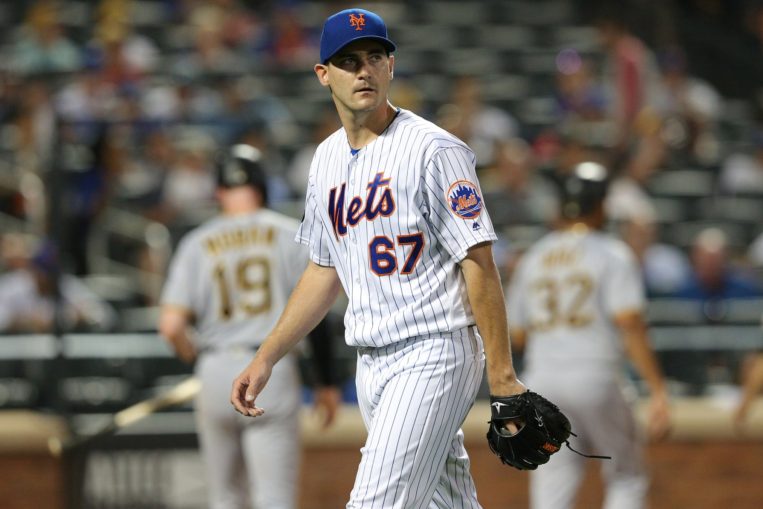
With an active general manager at the helm like Brodie Van Wagenen is for the New York Mets, virtually no name is safe from the trade rumor mill.
Just in the last couple months, Michael Conforto, Brandon Nimmo, Noah Syndergaard, and Amed Rosario all saw their names pop up in the news more than they’d like (for the wrong reasons, at least). After a recent report from The Athletic‘s Marc Carig, pitcher Seth Lugo can join that group. Like the teammates who came before him, though, it’d be real surprising to see the right-hander actually start 2019 on a team that’s not the Mets.
New York has spent a portion of the offseason adding to a bullpen that was not only the least valuable part of their roster, but one of the least valuable relief units in baseball. Based on his 2018 performance, it’s not shocking that opposing teams like the Houston Astros are interested in acquiring him. It just wouldn’t make sense for the Mets for all the obvious reasons — he was easily the best reliever in a very shallow bullpen, and he also provides legitimate depth in the rotation, which is an area the organization needs to give some love prior to Opening Day.
Lugo was one of the few consistent bright spots for New York last year, pitching to a 2.66 ERA and 1.08 in 101.1 innings, which led to 1.4 fWAR. Here are four encouraging stats from his breakout campaign to help show just how valuable he is.
Consistent Rise in Strikeouts
While Lugo’s 64-inning MLB debut in 2016 was a breath of fresh air for a team that really needed it, looking for signs of negative regression wasn’t hard. His 2.67 ERA was sterling, but he massively outperformed his peripherals. The right-hander produced just 0.3 fWAR and a 4.66 SIERA based off a 17.1% strikeout rate, 8.1% walk rate, .230 BABIP allowed, and 85.7% strand rate.
He did take a step back in 2017 before righting the ship this past year, but one thing that’s consistently been on the rise is his strikeout rate. After posting that 17.1% rate as a rookie, it rose to 19.5% in his second campaign prior to hitting a new high-water mark of 25.1% in 2018. Just as the league is adjusting to him, Lugo is also finding ways to adjust to opposing hitters.
Although only 23.0 of his innings were as a starter, it’s worth noting that his strikeout rate in that situation (26.5%) was higher than what it was as a reliever (24.7%). This doesn’t seem like a mirage — especially with a career-high 10.0% swinging-strike rate in tow, this current level of swinging and missing seems sustainable.
That Curveball, Though
Lugo’s curveball has been his calling card since getting promoted to the big leagues, but it took a huge leap forward in a number of ways last year. He threw it 31.9% of the time, which nearly doubled his previous single-season career high. Among all pitchers with at least 100 innings of work in 2018, only Lance McCullers (46.7%), Zack Godley (40.3%), and Rich Hill (35.7%) threw their curveball more often than Lugo.
More importantly, the value of his bender when it comes to a per-100-pitch basis (per FanGraphs), the right-hander’s curveball value of 1.72 was the eighth-highest mark in baseball when looking at the same group of hurlers.
His 25.7% strikeout rate with this pitch pales in comparison to how his four-seam fastball performed (42.5%), but opposing hitters mustered just a .181/.213/.236 triple slash against Lugo’s curve, which led to a .199 wOBA and 31 wRC+. This offering generated a 41.3% chase rate (highest among all of his pitches), and that was obviously a huge help in generating a 60.0% ground-ball rate (also highest among all his pitches).
Cutting Down on the Homers
As a group, the Mets bullpen had a home-run problem. Only the Cleveland Indians (1.51) and Washington Nationals (1.38) allowed more homers per nine innings than New York (1.35). Unsurprisingly, Lugo wasn’t part of this problem.
He actually went in the complete opposite direction — his 0.80 HR/9 was yet another career-best mark. It’s always helpful to see ground-ball rates rise and line-drive rates fall like Lugo’s did (46.5% and 20.3% in ’18, respectively), but his fly-ball rate (33.2%) was nearly identical to what it was in 2017 (33.9%).
The 29-year-old was much improved in this department because his hard-hit rate allowed decreased for the second straight season. After settling in at 38.4% as a rookie, it dipped down to 34.6% in ’17 prior to dipping even further to 31.0% this past year. Increased usage (and success) in his curveball undoubtedly contributed to that.
It’s also worth noting that Lugo was more stingy as a reliever than a starter. During his brief stay in the rotation, he allowed 1.57 homers per nine innings, but that number was just 0.57 when coming out of the bullpen.
He Improved as the Situation Got Tougher
When it comes to pitching with runners on base, Lugo made it clear that more pressure didn’t matter to him. Although the sample sizes are not at all equal, he stranded runners more often as a reliever (79.7%) than as a starter (65.6%). What’s really telling, though, is how his performance with the bases empty, runners on, and runners in scoring position compares to one another.
| Situation | AVG | OBP | SLG | wOBA |
|---|---|---|---|---|
| Bases Empty | .216 | .263 | .331 | .261 |
| Runners On | .208 | .285 | .312 | .253 |
| RISP | .181 | .269 | .231 | .207 |
It’s almost as if he’s trying to take a page out of Jacob deGrom‘s book. He was valuable to manager Mickey Callaway throughout this past year, but with Jeurys Familia and Edwin Diaz now set to team up for the eighth and ninth inning, Callaway will have more flexibility to use Lugo in high-leverage situations earlier in games.
This is all a really long way of agreeing with most people here — it’d be stunning if trade talks involving Lugo get anywhere, unless it’s a deal BVW absolutely can’t refuse. He’s too valuable to this team given the current makeup of the pitching staff, and the composition probably isn’t going to change all that drastically between now and Opening Day.














